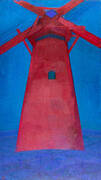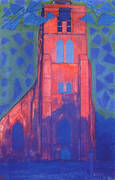Piet Mondrian Oil Painting Reproductions
Piet Mondrian replica paintings on Canvas for sale
Piet Mondrian Paintings: Colorful Abstract Art
Pieter Cornelis Mondriaan, better known simply as Piet Mondrian, was a Dutch painter and art theorist. A famous 20th century artist, he pioneered Abstract Art paintings in Europe. Today, we explore his life and the inspiration behind his colorful Modern Art.
On March 7, 1872, in Amersfoort, a province of Utrecht in the Netherlands. The family moved to Winterswijk a few years later. His father, Pieter Cornelius Mondriaan, was a head teacher at a local school. As a qualified drawing teacher, he encouraged Piet Mondrian to paint, and he enrolled in the Academy of Fine Art in Amsterdam in 1892. By then, he had qualified as a teacher and started painting himself.
Many of Piet Mondrian’s paintings from this period are conventional and naturalistic, mainly consisting of landscapes, windmills, and woodland scenes. Wood with Beech Trees 1899 and Windmill in Sunlight 1908 represent a new emerging approach. Inspired by the Impressionism of the Dutch Hague School, Pointillism, and Fauvism, they give fascinating insights into the artist's development. Despite their traditional subject matter, these pieces show some elements of the modern abstract art that followed.
What inspired Piet Mondrian's Paintings?
An intensely spiritual man, he joined the Dutch Theosophical Society in 1909. He was also profoundly interested in the work of Helena Petrovna Blavatsky, the Russian co-founder of the Society. Rudolf Steiner’s esoteric spiritual movement, Anthroposophy, was also influential.
Almost all Mondrian's paintings after 1914 pursue a quest to gain a profound spiritual knowledge of nature and its place in the world. Indeed, in 1921, he wrote to Steinar saying his Neoplasticism was the only “art of the foreseeable future.” He felt it was the natural creative expression of any true spiritual philosophy.
His arrival in Paris in 1911 marked a transformation for art by Piet Mondrian. In Paris, he discovered and fell in love with Cubist art, mainly the oil paintings by Pablo Picasso and George Braque. He first saw their work at an exhibition at the Moderne Kunstkring in Amsterdam early in 1911. He moved to Paris shortly after seeing their Cubist art. With hopes of integrating into the Parisian avant-garde, he also dropped the second “a” of the Dutch spelling of his surname.
Piet Mondrian paintings quickly adopted an abstract cubist style. By 1911, his paintings of trees exemplified this new geometric approach. He utilizes multiple layers of interlocking shapes and a severely restricted palette in oil paintings like The Grey Tree, Trees in Blossom, and Composition Trees II. Over the next few years, Piet Mondrian paintings progressed to more strictly abstract and geometric forms, as seen in the oil paintings Composition No. 10 Pier and Ocean 1915.
Abstract Paintings by Piet Mondrian?
Mondrian's cubist period painting dates from 1912 to 1917. After the outbreak of World War I in 1914, he stayed at an artists’ colony in Laren, in the Netherlands. Here, he met Theo van Doesburg and Bart van der Leck. The restrained primary colors used by Van der Leck significantly influenced him, and he moved away from strict cubism. Alongside Van Doesburg, he founded De Stijl, a Dutch art movement that came together in 1917. De Stijl introduced a new form of art to both paintings and architecture.
Piet Mondrian described his approach in 1914, “I construct lines and color combinations on a flat surface.” He wanted to reach “the truth and abstract” through horizontal and vertical lines arranged with “harmony and rhythm.” For the next twenty years, Mondrian's artwork adopts this style. He focuses on black lines, squares, and rectangles filled with primary colors bringing new meaning to modern art paintings.
In 1918 he returned to France after World War I ended and stayed there until 1938. Piet Mondrian flourished in the avant-garde culture of early 20th century Paris. His now iconic grid-based paintings appeared in early 1920. In early oil paintings Composition with Red, Blue, and Yellowish-Green, 1920, Mondrian’s lines are thin and gray, as opposed to thick and black. They also fade away towards the edge of the canvas rather than suddenly stopping.
As his style progressed, he gradually simplified his approach to include fewer and fewer forms. He also used white space between primary colors. Famous Piet Mondrian paintings include Composition Red, Yellow, Blue 1930.
What is Mondrian’s Art Style?
Translated from the Dutch as “the style,” the De Stijl art movement is heavily associated with Neoplasticism. As a theory, Neoplasticism informed the De Stijl artistic approach. Theo van Doesburg and Piet Mondrian were two famous artists who fought for abstract art in its purest form. Mondrian called it “pure, plastic art.” By this, he meant elementary geometric shapes arranged through rational means.
Consequently, Neoplasticism artworks comprise simple shapes, whites, blacks, and primary colors. The two primary directions, vertical and horizontal, were also acceptable compositional elements.
What are Piet Mondrian's Famous Paintings?
Composition Red, Yellow, Blue 1930 is a famous oil painting on canvas. It depicts a large red square in the top-right corner. This mass of red counterbalances a bright blue square in the bottom left. A yellow square bounded by thick black lines appears on the bottom right.
Around this time, however, Mondrian experimented with “lozenge works.” Also well-known today, they are tilted 45 degrees giving his paintings an intensely minimal and diamond shape. One of the most notable lozenge paintings is Lozenge Composition with Two Lines 1931. It consists of two black lines against a white backdrop and is a stunning piece of modern abstract art. Indeed, while showing a lozenge work in New York, Katherine Dreier, a co-founder of New York City's Society of Independent Artists, placed Mondrian alongside Rembrandt van Rijn and Vincent van Van Gogh as a true Dutch master.
As the 1930s progressed, Mondrian's paintings used double lines more often. He believed these double lines gave his works a new dynamism, exemplified in pieces such as Composition with Blue 1937.
1938 with World War II on the horizon, he left Paris for London. With the Nazis advancing across Europe, Piet Mondrian moved to New York City in 1940, where he remained in America until his death. In New York, his oil paintings became busier and fuller. With sadness for his earlier life, Mondrian often spent long hours painting until his hands blistered. He was often sick and cried in his studio.
What Colors are used in his most Famous Works of Art?
Piet Mondrian’s abstract modern art paintings used a limited color palette. Three primary colors, red, blue, and yellow, dominate his geometric paintings. These primary colors sit against the three primary values of gray, white, and black. In New York, Mondrian gradually moved away from black outlines. Instead, he focuses on colored lines. Mondrian paintings such as New York City I 1942 and the now famous Broadway Boogie Woogie are central to the theme. These Piet Mondrian paintings profoundly influenced subsequent American abstract art. They are upbeat and lively oil paintings which bely the sadness and destruction of World War II.
In 1943 aged 71, he moved to a studio at 15 East 59th Street in Manhattan. He recreated the same environment he had found so stimulating back in Europe. This involved painting the walls the same off-white as his canvases. He painted stools and furniture in primary colors and pinned the colored paper to the walls in ever-evolving combinations. Piet Mondrian said it was the best space he had ever created. Unfortunately, he could only the studio for a few short months, as he died early in 1944.
Mondrian died on 1 February 1944 from pneumonia. Buried at the Cypress Hills Cemetery in Brooklyn, New York, nearly 200 people attended the memorial service. Mourners included Marc Chagall, Marcel Duchamp, Robert Motherwell, and Fernand Leger.
Why is Piet Mondrian art unique?
His oil paintings are unique for their abstract nature, emanating from his spiritual beliefs. Piet Mondrian art searches for universal ideas and values. Indeed, in 1914, the artist proclaimed, “Art is higher than reality.” He believed artists needed to use reality as little as possible, considering that reality opposes the spiritual. Mondrian says that if artists failed in this task, art would have absolutely “no value for man.”
His legacy lives on today, and art by Mondrian continues to be enjoyed. Piet Mondrian geometric paintings can be seen in fashion, television, marketing, architecture, and computer coding. His unique aesthetic is everywhere. Described by critic Robert Hughes as “one of the supreme artists of the 20th century”, his colorful modern art lives on.
Piet Mondrian Artworks: Fine Art Reproductions
If you love Piet Mondrian’s modern abstract art, explore our extensive collection of Museum quality oil paintings on canvas. Enjoy reproduction oil paintings of famous to add a contemporary look to any space. We have been creating oil painting reproductions since 1996. Oil paintings are created entirely by hand by professional artists. There are many Good Reasons to Buy replica paintings from us.
Cannot Find What You Are Looking For?
Reproduction Gallery Information
Customer Service
(Send Us A Message)
Tel: (503) 937 2010
Fax: (503) 937 2011















